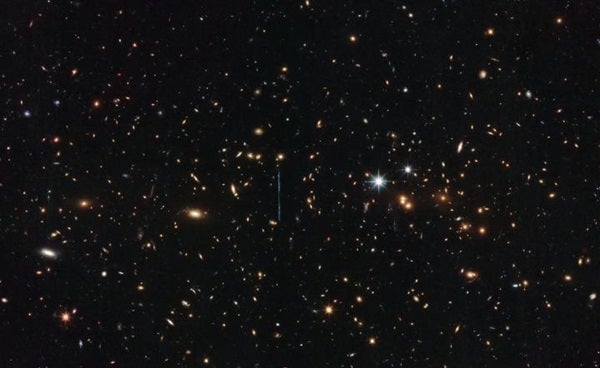Hubble’s Advanced Camera for Surveys and Wide-Field Camera 3 recently captured a photo of the mammoth galaxy cluster known as ACT-CLJ0102-4915. When it comes to X-ray clusters in the far off universe, this one is the brightest, hottest, and largest we’ve found to date.
In 2014, astronomers used the NASA/ESA Hubble Space Telescope to calculate the cluster’s official weight, and found that it has a mass of 3 million billion suns. The weigh-in, which was 43 percent higher than previous estimates, rightfully left the galaxy cluster with the nickname “El Gordo,” meaning “the Fat One” in Spanish. In El Gordo’s defense, observations made in 2012 by the Atacama Cosmology Telescope, ESO’s Very Large Telescope, and NASA’s Chandra X-ray Observatory revealed that it’s not one, but two galaxy clusters that are crashing into each other at millions of miles per hour.
Galaxy clusters are groups of smaller galaxies that gradually integrate over the course of billions of years. They are also the largest entities in the universe that are held together by gravity (except for the cosmic web itself). The formation of galaxy clusters greatly relies on dark energy and dark matter, and a 2014 study found that a substantial portion of El Gordo’s mass is disguised as dark matter. It’s believed that El Gordo’s non-dark matter, which is mostly made up of hot gas with bright X-rays, is being pulled away from the dominant dark matter as the two galaxy clusters collide. The collision is causing the hot gas to lose speed, as the dark matter maintains its steady pace.
Studying large galaxy clusters gives researchers further insight into the dark matter and dark energy that engulfs so much of our universe. NASA’s RELICS (Reionization Lensing Cluster Survey) program, which captured the image of El Gordo, locates distant galaxies for the upcoming James Webb Space Telescope to observe. NASA predicts that Webb will be able to locate the vast amounts of dark matter in these galaxies, and will help explain dark energy’s role in the historical acceleration of the universe.
To date, RELICS has photographed 41 massive galaxy clusters, and has also imaged the most distant galaxy ever caught on camera.










